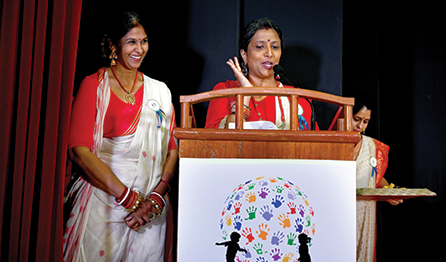The Elementary class’ year began with an overnight trip to Visakhapatnam. A group of 10 children comprising of 6 to 11 year olds were invited on this excursion for 4 days and 5 nights. The children were carefully chosen based on how they had responded to being away from their parents at sleepovers, how much impulse control they exhibited on a daily basis (particularly on field trips), and several other factors. The final group of 10 were children whom we felt absolutely confident taking on an extended trip!
While the location and final itinerary were chosen by the adults due to time constraints, these children weighed in on all the initial research. They decided on logistics such as transportation after comparing costs. They decided which accommodation options made economic sense, and called to check for availability. They also made follow-up calls to confirm our itinerary with experts such as heritage walk guides. Needless to say, their calls helped charm the group’s way into several discounts and freebies 🙂
As we set off on day one, there was a lot of excitement. Most of the children had never been on a local train before, let alone in a sleeper class berth. They jumped from one berth to the other, shouted across compartments, and had a lot of fun discovering how the lights switched on and off. They also commented loudly on what they would and would not eat, and banged the toilet door for fun. Needless to say, this did not go over well with the other passengers on the train. They were repeatedly reminded, collectively as well as individually, to be considerate. There wasn’t too much of an impact, perhaps because the children believed there would be no real consequences to their actions beyond some adults on the train telling them off.
However, as we told them, if they weren’t respecting our instructions in a closed safe space, there was no guarantee that they would listen to us when we were out on the road either. For the sake of their own safety, we could not take them out unless we saw signs that they could consistently follow instructions. We could not take them out until they showed us that they were capable of awareness of the people around them. For the first half day that we were in Vizag, all we did was remain indoors at the house where we were staying. We waited until the children demonstrated courtesy, and a respect for property as well as the people around them.
After this, six children who displayed this behaviour were invited to go on a cable car ride and visit Kailasagiri. They had a gala time… and they remembered to be considerate of the group! The children left behind were very surprised that their less-than-desirable behaviour had actual outcomes. When they saw that all the adults on the trip were consistently on the same page, and that there would be no wiggle room, they started to live up to our expectations too. The entire group visited Visakha museum, where they learned a lot about India’s naval history. At the end of the day, several of them mentioned it was the first time that they had been solely responsible for their own belongings (including re-packing or separating used clothes). They were clearly eager for the opportunity to demontrate their maturity 🙂

Day two began with an early morning drive to Thottlakonda, a BC-era Buddhist site. We were fortunate to be walked around by Ms. Jayashree, a heritage guide, who told us fascinating stories about the place, and Buddhist rituals. Chanting at the same spot where Buddhists had centuries ago, was goosebump-inducing. After a picnic-style breakfast, we took a long drive down to Yarada Beach. Once again, the children whom we believed could not be trusted in open spaces yet were asked to remain in the car and practice being mindful until they could join us. We were very happy to note that the children who could go to the beach still opted to stay back and coach the remaining children! There was already a strong sense of community within the group, where they wanted everyone to be able to join in. When they were ready, we had a fantastic few hours playing together in the waves. We then visited the submarine museum and aircraft museum in the city before winding up with a delicious home-cooked dinner.
We wanted to camp overnight at Arakku Valley on day three, but bus transportation had been stopped due to local tensions. We quickly formed an alternate plan and took the children to Kambalakonda, a wildlife sanctuary closeby. The adventure park there let them zipline, do a sky walk, and much more. Again, they were very empathetic to each other’s needs, and, by now, none of them were saying, “I want this,” or “Can you buy me this?” Rather, they were all aware that the group’s plan superceded any individual child’s urges, and that any decisions we made would have to be made as a group. They were also very aware of budgets, safety, and the need to thank people for their help. We drove back to our house with stops at the Ramanarayanam temple and Vijayanagaram fort nearby.
On our final day in Vizag, we visited Ms. Lata’s horseback riding school in the morning. She graciously invited the children to participate in all the work at the stables rather than merely enjoying a joyride. As they mucked out stalls and helped feed the horses, the children spent some time thinking about how animals have a lot of qualities which human beings would do well to emulate. Sitting in a circle in the mud, out in the open, they discussed the importance of treating even the smallest creature with care. We couldn’t help but marvel at how far these children had come since that first night on the train – they were now capable of not just putting up with unfamiliar experiences, but actually open to them!
We took them out for lunch to a local restaurant and ordered ragi mudde. To our delight, and the children’s surprise, quite a few wanted seconds! Those who didn’t had the will power not to remark disparagingly on what anyone else was eating, or to demand an alterative. They were all eating vegetables without complaint (one of the children said it wasn’t until this trip that he had been made to eat them!) and they even walked through Vizag’s well-known fish market later in the day without making any insensitive remarks about the smells or sights.
 We wound up our trip with another visit to Visakha museum, where we spent time studying the human history display. The older children helped the younger ones read signs, or paraphrased for them. When we boarded the train back, neither us nor the children wanted to go back home! It had been a lovely excursion, with lots of learning for the group. We look forward to more adventures next January.
We wound up our trip with another visit to Visakha museum, where we spent time studying the human history display. The older children helped the younger ones read signs, or paraphrased for them. When we boarded the train back, neither us nor the children wanted to go back home! It had been a lovely excursion, with lots of learning for the group. We look forward to more adventures next January.












